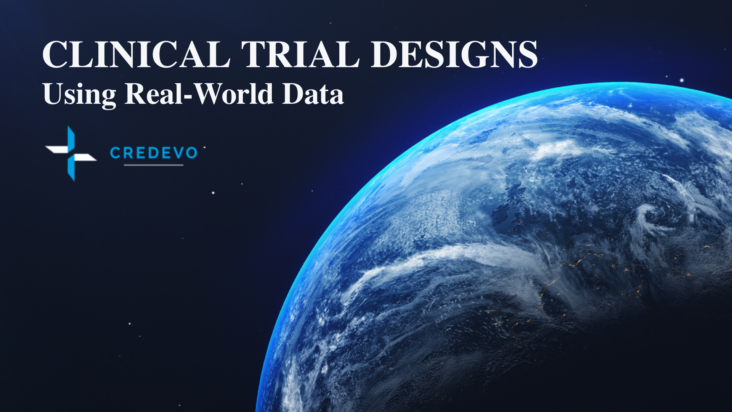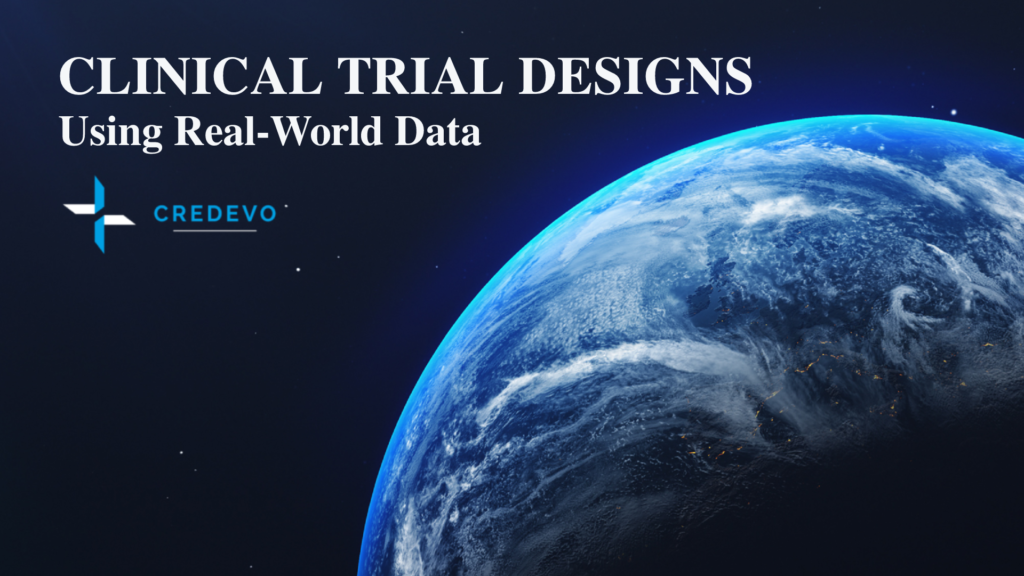Trial Designs Using Real-World Data (RWD)

Real-world data (RWD) and real-world evidence (RWE) are playing an increasing role in health care decisions and now in clinical trial designs. The gold standard for demonstrating the efficacy of clinical trials since the 1960s has been randomized controlled trials (RCTs). We require at least two pivotal RCTs on the market for investigational medications. RCTs can be time-consuming, expensive, and yield evidence that is not always applicable in clinical practice.

RCTs may not accurately reflect the actual conditions of patients. Therefore, there is a move to look at creative approaches to increase the effectiveness of clinical research. So we require observational studies to assist with further data collection, particularly concerning safety-related issues.
We can gather real-world data (RWD) from several sources.
- patient registries
- Healthcare databases
- claims databases,
- patient networks
- social media
- patients.
To produce Real World Evidence that offers sufficient scientific evidence for regulatory decision-making, unique trial procedures that combine the best elements of standard RCT and observational study designs are required.
RWD improves enrolment process for clinical trials
Procedures for enrolling participants can consume up to 40% of the budget for clinical trials. Because of competing studies and low participation rates, sponsors frequently encounter difficulties choosing the optimal sites and enrolling the desired number of patients.
The Tufts Center for the Study of Drug Development estimates that enrolment is insufficient at more than one-third of the sites. Utilizing RWD can boost enrolment in three different ways.
- First, by evaluating the protocol’s viability based on the inclusion and exclusion criteria, researchers can utilize RWD to estimate the size of the patient population.
- Identify eligible patients by the provider, we can apply the criteria to de-identified patient data from EHR systems that enables sponsors to concentrate on locations that serve a population that meets the protocol requirements.
- The software can be set up to alert doctors when suitable patients are present in their practices, allowing them to secure consent and enrol potential study participants. Sponsors can take a more strategic approach to trial planning and recruitment by utilizing RWD and focused analytics, which helps them rely less on traditional techniques.
Real World Data’s potential to bring out Real World Evidence benefits
- RWD lays the groundwork for data collection during investigations with the help of advancing approval for trial preparation and patient enrolment. A single study may access 100 data assets in the healthcare ecosystem, each containing millions of patients.
- Insights gained from RWD collected during or as a result of clinical care,
- streamline clinical trial recruitment
- increase patient access
- support regulatory filings
- carry out drug safety surveillance
- Increase the effectiveness of the drug development cycle.
- RWD has become even more crucial since health authorities demand sponsors to compile extra data on safety, effectiveness, and best practices once it is on the market.
How can sponsors successfully overcome obstacles?
How can sponsors successfully overcome obstacles like privacy laws, technical difficulties, and altering legislation to utilize real-world data and, eventually, the advantages of real-world evidence?
The numerous difficulties in using RWE in trials range from poor analysis and research design to problems with data quality, such as inconsistent data. Several government agencies and organizations are there to improve RWE so that those working in the healthcare industry can enhance the betterment of patients.
- The Institute for Patient-Centered Outcomes Research.
- The NPCR Network for National Patient-Centered Clinical Research.
- The Precision Medicine Cohort at the National Institutes of Health
Regulators are ready to accept new RWD and RWE approaches
- Health Canada published guidelines to maximize the use of RWE for regulatory decision-making.
- Health Canada approved an expansion of the currently approved pediatric indication for Prevnar 13 to include acute otitis media in children aged six weeks to five years old, using real-world data from the National Ambulatory Medical Care Survey.
- A joint agreement created by Health Canada and its Health Technology Assessment (HTA) partners will codify and improve the use of RWE throughout the drug life cycle.
- According to draft guidance published by the Chinese National Medical Products Administration, they have used RWD and RWE for regulatory labelling.
Although not all regulatory bodies agree that RWE could have a role in regulatory decision-making, there is a growing recognition that we can advance the existing medication approval process by using RWD and RWE.
Examples of current regulatory projects to advance the use of RWD and RWE in clinical trials
| The Project | Details |
|---|---|
| Advise submitting documentation to the FDA for pharmaceuticals and biologics that contains real-world data and evidence. | By providing information on their usage of RWE in a clear, consistent style, sponsors and applicants who are employing RWD to produce RWE as part of a regulatory submission to the FDA are encouraged by this recommendation. |
| Real-world evidence program framework in FDA | The FDA published a framework to assess the potential use of RWE to support new indications for medicines that have already received approval or to fulfill post-approval study requirements. This plan shows a dedication to changing the medication development process. |
| FDA recommendations on electronic health records (2018) | This advice underlines the necessity of maintaining the audit trail and crediting the data originator. Furthermore, it reaffirms the possibility of using RWE to support the approval of new uses for already-approved medications and to fulfill post-approval research criteria. |
Emerging RWE rules suitable for regulatory purposes
- The FDA must expedite the medication development and approval processes under the 21st Century Cures Act and PDUFA VI.
- The FDA must produce instructions to include patient viewpoints and cutting-edge study designs, such as RWE, in the drug development process.
- The regulations for RWE that are appropriate for regulatory reasons must be defined.
Even though regulators are open to proposals for studies with RWD and receiving RWE, the decision to pursue an innovative study design as part of a clinical development program and regulatory approval strategy is not simple. The processes for obtaining pilot guidance are complicated. The “rules” for accepting evidence in regulatory decision-making are not yet firmly established. Before undertaking a study that might not satisfy the regulatory aims, it is crucial to interact with regulatory authorities to gain objectives, guide the study design, and ensure that the study design meets the regulatory goals.
Updating the tradition RCT
The FDA is considering the following three main categories for regulatory decision-making for some specific hybrid study designs:
- Investigational new drug submissions for RCTs that use RWD to record clinical outcomes or safety data.
- Single-arm clinical trials using RWE to satisfy a post-marketing requirement for additional evaluation of safety or effectiveness to support a regulatory decision.
- Clinical trials using RWE to support a regulatory decision.
Pragmatic and large-scale simple trials
Real-world evidence has the potential to reduce costs, boost investment incentives in life sciences, and replace a portion of the clinical trial process. Utilizing more real-world situations and experiments is an alternative strategy. The research designs of these pragmatic clinical trials, also known as large simple trials, allow for the inclusion of more diverse patient groups in studies.
Explanatory trials concentrate on quantifiable symptoms or signs, whereas pragmatic trials examine a wide range of outcomes, typically patient-centered (clinical or biological). Clinical trials can become more effective by cutting administrative expenses for sponsors and companies doing the studies.
Application of Artificial Control Arms in Clinical Trials
RCTs will continue to be the foundation of the evaluation of medications. The synthetic control arm helps to assess the intervention for a novel treatment. Via propensity score matching, we can balance the baseline characteristics of the artificial control arm and the randomized control arm.
Both one-arm studies and randomized trials have artificial or external control arms. By utilizing several sources, we can use RWD and RWE as a comparison for the SCAs.
RWD-based long-term follow-up studies
Observational designs and methodologies depend on post-marketing responsibilities and requirements. RCT-based safety evidence is necessary for several situations for pragmatic reasons. The evaluation of efficacy outcomes is frequently a secondary goal of these investigations. The regulatory framework for RWE, new technology, and data create new options for conducting efficient safety and efficacy studies.
RWD is a step toward hybrid study designs to boost clinical efficacy if we gather RWD using strategies like decentralization, direct-to-patient approaches, or databases. These cutting-edge methods may also be helpful when conducting long-term trials of experimental medications before licensure, especially when the outcomes of interest in terms of safety and effectiveness necessitate longer follow-up times.
Conclusion
- The creation and improvement of hybrid study designs maximize the advantages of both RWD and RCTs while reducing their drawbacks.
- If regulators and other players continue to adopt RWE, medication development could become more effective and result in a paradigm shift in the drug approval process.
- To fully realize the scientific promise of RWD, regulators, pharmaceutical companies, and RWE experts will need to collaborate early on to develop novel study designs that yield trustworthy and reliable RWE.
- A logical and essential step is the expansion and future-proofing of the regulatory approval system where we can use RWD-based trial designs.
Are You Looking For The Ways To Accelerate Your Clinical Trials?
Credevo offers strategies to complete your clinical trials faster and in cost-effective ways. Our expert team provides end-to-end solutions for your clinical trials.